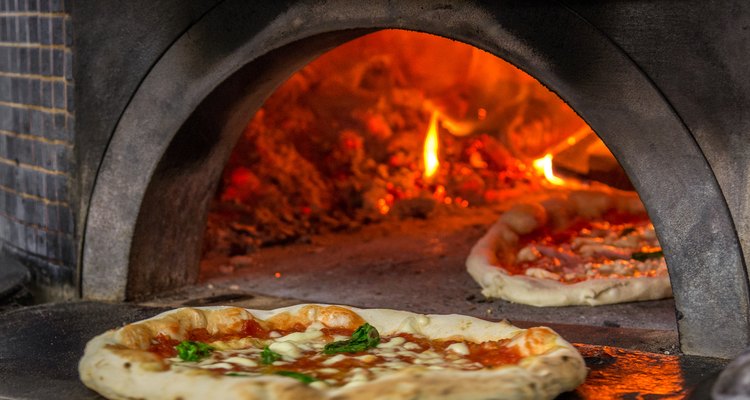
CatherinaUnger/iStock/GettyImages
Cooking and baking in clay ovens dates back to the earliest civilizations, more than 6,000 years ago. These ovens produce evenly cooked foods and are prized for making fine breads and pizza, but can also be used for meats and poultry. Because clay ovens rely on residual heat, typically from a wood fire, they offer a range of baking capabilities from quick cooking when the fire is hot to slow cooking for hours as the temperatures gradually decrease.
Fast and Furious
Heating the clay oven with a wood fire takes time, but according to Simon Brookes, author of “How to Build a Traditional Wood-Fired Clay Oven”, the internal temperature of a clay oven reaches approximately 450 degrees Fahrenheit three hours after the initial firing. At this temperature, he claims that you can bake a pizza in about 30 seconds and explains that an hour later pizza will cook in 1 to 1.5 minutes. For foods that benefit from quick cooking, this is the time to get them into the oven and take advantage of the high temperatures generated by the wood fire.
Easy Does It
Not all food, of course, benefits from cooking quickly. Meats, poultry and breads benefit from slower cooking at lower temperatures. Clay ovens create the perfect environment for slow cooking. When closed tightly after the initial fire dies down, the heat in a clay oven lasts for hours and may even last overnight, says Brookes. This is the time for adding those inexpensive cuts of meats, or meats and poultry to shred for other meals. Let them cook slowly for several hours to bring out the natural flavors and tenderize the meat. Beans also benefit from hours of baking, but remember to check them and add water as needed.
Firing the Oven
Firing the oven at least three hours before you plan to cook insures that your clay oven heats fully and evenly. This means building a wood fire at the back of the oven and maintaining the fire for the entire time. Around the three-hour mark, the insides of the oven should glow white with no traces of soot remaining on the walls or ceiling from previous cooking. At this stage, letting the fire die down allows you to manipulate the embers, using heatproof equipment to distribute the heat to the floor of the oven and prepare for baking.
The Mechanics of Cooking
After heating the oven floor with glowing embers, move them to the sides of the oven and clean the oven floor with a scuffle, which looks like a rag attached to a hardwood handle with a chain, similar to a mop. Scuffling the bottom of the oven removes ashes and soot and prepares it for baking. Bread or pizza can be placed on the oven floor with a paddle or baked in pans placed inside the oven. Veggies and meats can be cooked in open pans, while stews and savory mixtures perform best in covered pots or dutch ovens. The coals lining the sides of the oven continue to release heat into the oven while your food bakes. Cooking time varies, depending on the temperature of your clay oven. You can purchase inexpensive stand-up thermometers for high-heat ovens that measure oven temperatures up to 750 degrees Fahrenheit.
Related Articles

Can You Cook Pizza Directly on Fire ...

Is Revere Ware Aluminum?

How to Clean an Oven Liner
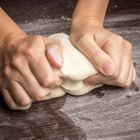
How to Bake Bread in Stoneware

How to Bake a Cake in a Covered Gas ...

How to Cook With a Gas Fireplace
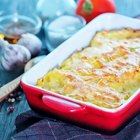
What Are the Benefits of Stoneware ...

How to Grill With a Pizza Stone and ...
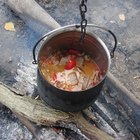
Dutch Oven Cooking Schools
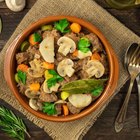
Can You Oven Cook With Pottery?
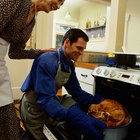
Baking Vs. Roasting in Convection Ovens
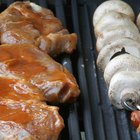
How to Use a Smoker Box for Gas Grilling

How to Use a Probe Cooking Thermometer
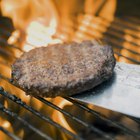
How to Convert a Brinkman Smoker From ...
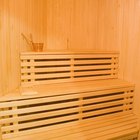
Sauna Cleaning Requirements
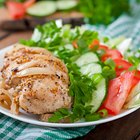
How to Cook Chicken Breasts in a ...

How to Conserve Natural Gases

What Is Better for Cookware: Glass, ...

How to Cook Cakes and Biscuits in a ...
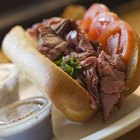
How to Cook Roast Beef in a Baby George ...
References
Resources
Writer Bio
Nannette Richford is an avid gardener, teacher and nature enthusiast with more than four years' experience in online writing. Richford holds a Bachelor of Science in secondary education from the University of Maine Orono and certifications in teaching 7-12 English, K-8 General Elementary and Birth to age 5.